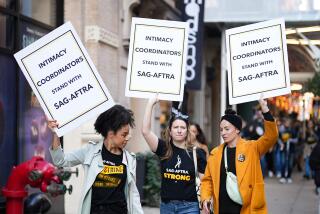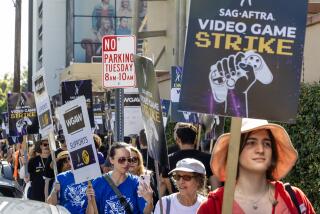Plot twist in union talks: stars vs. stars
Some actors are lining up behind Tom Hanks. Others are backing Jack Nicholson.
No, this is not an Oscar race. It’s the campaign over a new contract for Hollywood actors, and the two movie stars are on opposing sides regarding what to do about it.
Welcome to the civil war that has turned Hollywood upside down and is fast diminishing the prospects of a peaceful resolution between actors and studios.
With the entertainment industry’s major contract with actors set to expire at midnight, Hollywood is bracing for its second period of labor unrest this year. But this time the turmoil is exacerbated by an ugly family feud that is pitting actor against actor.
In recent weeks the dominant actors union, the Screen Actors Guild, has mounted a highly unusual campaign to scuttle a new agreement negotiated by the smaller American Federation of Television and Radio Artists. The effort -- targeted at 44,000 members who belong to both unions -- has split the ranks of actors, with stars lining up on opposite sides as their leaders trade daily barbs in e-mail blasts to their members.
“I’ve never seen anything like this,” said former SAG President Richard Masur, who is a member of SAG’s national board. He called his union’s campaign “incredibly divisive.”
Masur is among more than 600 actors including Hanks, Susan Sarandon, Kevin Spacey and Alec Baldwin who recently signed a letter in support of the AFTRA accord, which they describe as a good agreement. “If this deal doesn’t pass it will take us to a place from which we may not recover,” the actors warned.
SAG, however, has lined up its share of high-profile backers, including Nicholson, Ed Harris and Viggo Mortensen, who delivered a personal message of support posted on the union’s website.
“We have right on our side and we ought to support our SAG negotiating team,” said Mortensen, a star of the “Lord of the Rings” trilogy.
Then there’s a third camp led by George Clooney, who staked out a middle ground by calling on both unions to end their warring and stop “pitting artist against artist.”
AFTRA’s tentative contract includes pay hikes for actors and is modeled on similar pacts negotiated by writers and directors. But SAG leaders say it doesn’t address their bargaining goals, such as increasing the residuals that actors earn from DVD sales, giving them a say in how products are pitched in TV programs and ensuring that all shows created for the Web are covered under the union’s contracts.
SAG is spending as much as $150,000 in a barrage of ads, automated phone calls and e-mails to urge joint members to vote down the agreement. Results of the vote by AFTRA’s full membership will be announced July 8 and could be a litmus test for whether SAG has enough support to wage a strike. AFTRA, which has 70,000 members, has called the effort a “politically motivated disinformation campaign.”
Regardless of the vote results, it’s highly unlikely that the unions will patch up their differences any time soon, given their long history of sparring over turf. The two unions have clashed for years over which group can lay claim to actors who work in cable television, and now the battle is shifting to the more high-stakes world of prime-time TV.
Although the 120,000-member SAG currently dominates prime time and feature films, the rival union is poised to eventually capture a number of new prime-time dramas and sitcoms, thanks in some part to friendlier relations with the studios.
That could give AFTRA a level of clout it hasn’t seen since the 1970s and ‘80s, when the federation represented actors in such hit sitcoms as “The Cosby Show,” “All in the Family” and “The Facts of Life.” It also could pose a serious competitive threat to SAG, given that AFTRA already dominates reality programs and daytime television.
AFTRA currently covers nine prime-time shows, including the HBO comedy “Curb Your Enthusiasm” and the new CBS series “Project Gary.” The federation represented 22 prime-time pilots produced this year and all the actors in them, up from 16 last year. By comparison, SAG represented 33 produced pilots.
The unions have had an uneasy alliance since 1981, when they formed a joint bargaining pact that recently fizzled after AFTRA accused SAG of attempting to poach one of its soaps, “The Bold and the Beautiful,” a claim disputed by SAG and the show’s star, Susan Flannery.
For most of the last two decades, the unions had largely respected each other’s jurisdictional boundaries: AFTRA handled shows “recorded live,” reflecting its origins in radio, and most programs shot on videotape, while SAG had dibs on everything captured on film.
But those lines have been blurred in recent years as more shows are shot with digital technology, supplanting the older formats. Each guild claims jurisdiction over digital, setting the stage for conflict, especially in cable TV, in which AFTRA has made significant inroads.
In the last four years, for example, AFTRA’s share of scripted dramatic basic cable shows has grown to 55% from 15% as the union signed deals with producers of such shows as “Army Wives” on Lifetime and FX’s “Dirt.” During the same period, SAG says its share has shrunk to 45% from 85%.
Producers and studio executives praise AFTRA for being easy to work with and willing to tailor contracts that reflect the tight budgets of cable TV shows, which are a fraction of those on network television.
“They showed a willingness to appreciate the financial difficulties of making quality at a price,” said Stan Rogow, who produced the NBC kids drama series “Flight 29 Down” in 2005 under an AFTRA contract.
Unlike terms for prime-time television, which the unions have until recently negotiated jointly, contracts for scripted dramatic cable programs are hammered out separately, often leading to widely divergent contract terms that can yield big differences in how much actors are paid.
Indeed, every time Rondell Sheridan sees a repeat of “Cory in the House” he cringes. Not about his performance as Cory’s dad, he said, but because he has yet to collect a penny in residuals, the extra payments that actors get from reruns.
That’s hard to take given that he has collected several hundred thousand dollars in residuals from his work on “That’s So Raven,” the hit cable series that spawned the “Cory” spinoff.
Although both shows appeared on the Disney Channel, “Raven” was made under a SAG contract whereas “Cory” was covered under an AFTRA contract.
“You’re doing the same job and making less money than you did the last time,” Sheridan said. “I felt betrayed.”
SAG Executive Director Doug Allen seized on the issue a year ago, when he wrote a controversial article in the guild’s magazine that accused AFTRA of signing “bargain-basement” agreements with cable producers to undermine pay terms negotiated by SAG.
“They’re acting like we’re Hertz and they’re Avis,” Allen said in an interview. “They’ve been trying to gain market share by undercutting our contracts.” AFTRA says such criticisms are spurious, arguing that its contracts reflect economic realities of low-budget cable shows and have enabled some programs to exist that might not otherwise, thereby creating more work for union members.
“Analyzing the question as a zero-sum contest between two unions is ridiculous,” said Kim Roberts Hedgpeth, AFTRA’s executive director.
Hedgpeth notes that her union played a key role during the early days of cable to ensure that such networks as Nickelodeon and Comedy Central would be covered under union agreements. The federation often renegotiates contracts once shows get their footing. AFTRA, for example, has negotiated a new contact with the producers of “Cory” to improve pay terms, she said.
“Our primary concern,” Hedgpeth said, “is making sure that there is work for actors and other performers . . . with the protections of a union contract.”
--
More to Read
The biggest entertainment stories
Get our big stories about Hollywood, film, television, music, arts, culture and more right in your inbox as soon as they publish.
You may occasionally receive promotional content from the Los Angeles Times.










